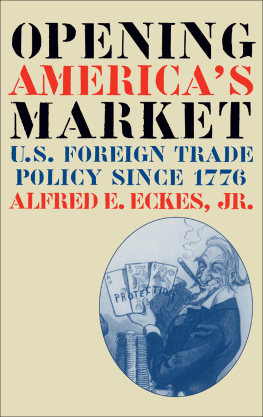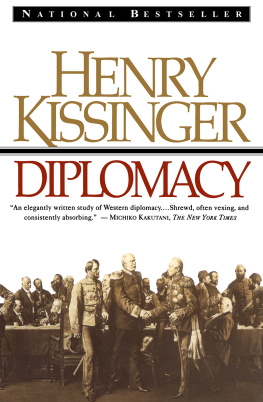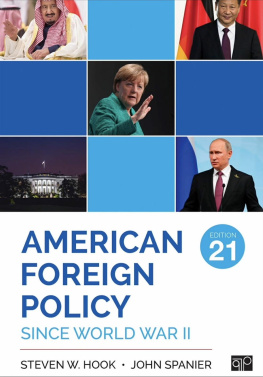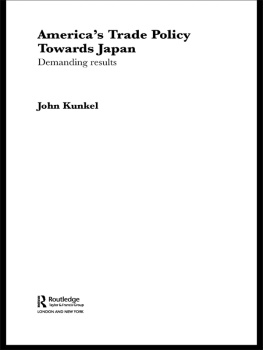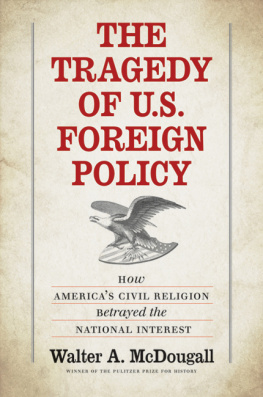Opening Americas Market
LUTHER HARTWELL HODGES SERIES
ON BUSINESS, SOCIETY, & THE STATE
William H. Becken, editor
1995 The University of North Carolina Press
All rights reserved
Manufactured in the United States of America
The paper in this book meets the guidelines for permanence and durability of the Committee on Production Guidelines for Book Longevity of the Council on Library Resources.
Library of Congress Cataloging-in-Publication Data
Eckes, Alfred E., 1942
Opening Americas market: U.S. foreign trade policy since 1776 /
Alfred E. Eckes, Jr.
p. cm.
Includes bibliographical references and index.
ISBN 0-8078-2213-2 (cloth: alk. paper)
ISBN 0-8078-4811-5 (pbk.: alk. paper)
1. United StatesCommercial policy. 2. ExportsUnited StatesHistory. 3. Free tradeUnited StatesHistory. 4. United StatesCommercial policySources. I. Title.
HF1455.E28 1995
382.30973dc20 95-2791
CIP
An abbreviated version of Chapter 4, Infamous Smoot-Hawley, appears as Revisiting Smoot-Hawley in the Journal of Policy History 7, no. 3 (Summer 1995).
Chapters 5, 6, and 7 include some material published first in Trading American Interests, Foreign Affairs 71, no. 4 (Fall 1992): 135-54.
02 01 00 99 98 7 6 5 4 3
THIS BOOK WAS DIGITALLY PRINTED.
Contents
Tables
2.1 U.S. Customs Duties and Federal Revenue, Selected Years from 1860 to 1992
2.2 Comparative Annual Growth of Real Gross Domestic Product in Selected Countries and Western Europe, 18701913
2.3 Comparative Export Growth Rates in Selected Countries and the World, 18701913
2.4 Comparative Tariff Levels, 1913
2.5 U.S. Growth in Gross National Product and Per Capita GNP, 18901910 and 19721992
2.6 U.S. Growth in Gross National Product and Per Capita GNP, 18891929 and 19521992
4.1 U.S. Tariff Levels, Selected Years from 1828 to 1992
4.2 U.S. Dutiable and Duty-Free Imports, 1920 and 1923
4.3 U.S. Dutiable and Duty-Free Imports, 19291936
4.4 U.S. Exports by Region and Principal Country, 19291932
4.5 U.S. Exports by Product, 19291931
6.1 U.S. Concessions in Multilateral Trade Negotiations, 19471967
6.2 Kennedy Round Tariff Concessions on Manufactures: Average Tariff on Dutiable Imports as a Percentage of Cost, Insurance, and Freight Value
7.1 Section 201: Escape Clause Filings and Results, 19751993
8.1 U.S. Introduction of Antidumping and Countervailing Duty Orders, 19601990
Illustrations
The Goose That Lays the Golden Eggs
Englands Candidate for the American Presidency
The Declaration of Dependence, July 4, 1888
An Old Game
Standing Pat
Our Choked Up Home Market
A Successful Gate
Senator Reed Smoot and Representative Willis Hawley
Introduction
Congress shall have the power
1. To lay and collect taxes, duties, imposts, and excises ...
3. To regulate commerce with foreign nations, and among the several States, and with the Indian tribes. (emphasis added)U.S. Constitution, art. I, sec. 8
Were at war, Deputy Commerce Secretary Clarence J. Bud Brown exclaimed as he arrived at the Capitol Hill Club for lunch.
Have the Russians bombed New York? I wondered, or has President Reagan retaliated against Japanese trade barriers?
At war with whom? I asked.
With Congress, of course, Brown responded.
Browns comment in September 1985 reflected the unique culture of Washington, D.C., where Democrats and Republicans shared the government and battled relentlessly for advantage. With one party entrenched in Congress and the other holding the White House, the real enemy often seemed only sixteen blocks away. Until the bitter 1993 debate over the North American Free Trade Agreement (NAFTA) energized ordinary Americans and fractured the two major political parties, trade struggles usually aroused only Washington insidersa group largely composed of U.S. officials, foreign representatives, and lobbyists. Many of the lobbyists were former presidential appointees who chose to remain near the center of government power representing business interests, especially foreign corporations eager to share the giant American
Particularly in the half century after World War II pundits, editorial writers, and cartoonists portrayed inside-the-Beltway conflicts over trade policy as battles in the unceasing war between executive branch free traders and congressional protectionists. Executive officials wore white hats and supported deregulating trade, opening markets, acting as responsible creditors, and promoting economic cooperation among nations. With trade liberalization, Americans would benefit as producers, workers, and consumers.
Columnists dismissed congressional opponents as troglodyte protectionists, ignorant of generally accepted economic wisdom. Depicted as wearing black hats, these supposedly parochial politicians responded to special interest appeals from local constituents, greedy labor unions, and declining industries. According to the media, the foes of trade liberalization jeopardized Americas role as a world leader when they sought to restrict the presidents trade negotiating authority. If Congress, or the president, took action to aid domestic industries, the press gleefully invoked memories of Smoot-Hawley protectionism, the Great Depression, trade wars, and foreign retaliation.
Simplistic images, slogans, and mythsall reflecting unfamiliarity with the factual recordstill shape American attitudes toward trade policy. As a historian who left academic research and teaching for more than a decade to work as a journalist and serve as a federal official, I believe it is time for scholars and public officials to revisit the historical documents. They should also examine critically the familiar stereotypes and interpretations in light of facts and consider trade policy issues in a more robust manner.
This book has four specific goals. The first is to offer an introduction to, and an interpretation of, some two centuries of American trade policy. While preparing for congressional hearings in 1981, I could find no extensive scholarly study of U.S. commercial policy based on substantial research in archival sources. This book may serve the informational needs of future government officials, opinion makers, scholars, and other interested persons.
My second related goal involves encouraging government officials to examine issues in a historical perspective, paying greater attention to archival records and to the writings of scholars. Policymakers also may find the present discussion a useful supplement to the limited institutional memory available in most government agencies. While serving as a trade decision maker, I was shocked to find that U.S. officials had little information about the origin and evolution of present policies and about the results of previous negotiations. This absence of historical memory is a distinct disadvantage in international negotiations, when frequently inexperienced U.S. officials match wits with adversaries having years of relevant experience.
While researching these issues, I discovered archival evidence and data that compelled me to reconsider key elements of the conventional trade wisdom. Thus a third objective is to correct the public record, and to question several popular myths that continue to influence thinking about international trade policy. My conclusions may spark debate and force public officials and scholars to revisit the empirical record.

